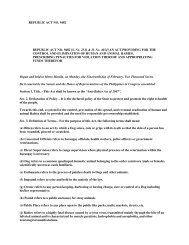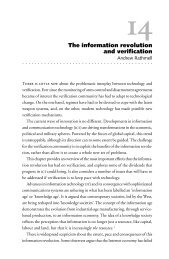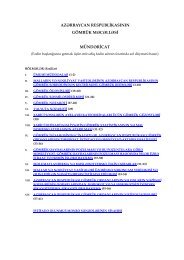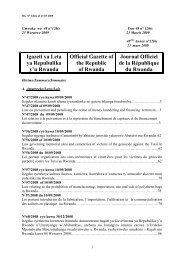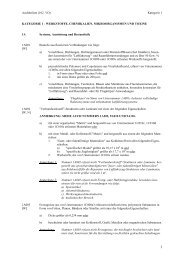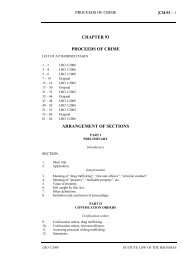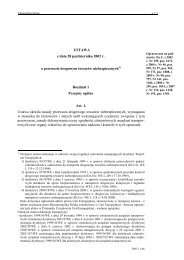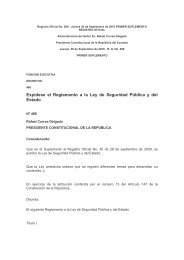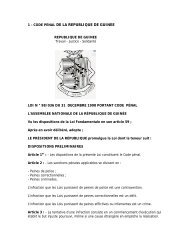- Page 1 and 2:
This document is meant purely as a
- Page 3 and 4:
▼B (7) Common lists of dual-use i
- Page 5 and 6:
▼B (19) Each Member State should
- Page 7 and 8:
▼B CHAPTER II SCOPE Article 3 1.
- Page 9 and 10:
▼B Article 6 1. The transit of no
- Page 11 and 12:
▼B (c) not be used if the exporte
- Page 13 and 14:
▼B (d) considerations about inten
- Page 15 and 16:
▼B 3. Without prejudice to any po
- Page 17 and 18:
▼B (b) the quantity of the dual-u
- Page 19 and 20:
▼B ▼M1 ▼B ▼M1 2. The Chair
- Page 21 and 22:
▼M2 ANNEX I List referred to in A
- Page 23 and 24:
▼M2 Controls on ‘technology’
- Page 25 and 26:
▼M2 Acronym or abbreviation Meani
- Page 27 and 28:
▼M2 DEFINITIONS OF TERMS USED IN
- Page 29 and 30:
▼M2 ‘Civil aircraft’ (1 3 4 7
- Page 31 and 32:
▼M2 ‘Dynamic signal analysers
- Page 33 and 34:
▼M2 ‘Fusible’ (1) means capab
- Page 35 and 36:
▼M2 ‘Local area network’ (4 5
- Page 37 and 38:
▼M2 ‘Natural uranium’ (0) mea
- Page 39 and 40:
▼M2 ‘Radar frequency agility’
- Page 41 and 42:
▼M2 ‘Signal processing’ (3 4
- Page 43 and 44:
▼M2 ‘Time constant’ (6) is th
- Page 45 and 46:
▼M2 CATEGORY 0 NUCLEAR MATERIALS,
- Page 47 and 48:
▼M2 0B Test, Inspection and Produ
- Page 49 and 50:
▼M2 0B001 c. (continued) 5. Heat
- Page 51 and 52:
▼M2 0B001 (continued) g. Equipmen
- Page 53 and 54:
▼M2 0B001 j. 5. (continued) b. Ou
- Page 55 and 56:
▼M2 0B005 Plant specially designe
- Page 57 and 58:
▼M2 0C Materials 0C001 ‘Natural
- Page 59 and 60:
▼M2 0D Software 0D001 ‘Software
- Page 61 and 62:
▼M2 CATEGORY 1 SPECIAL MATERIALS
- Page 63 and 64:
▼M2 1A002 Note 2: (continued) b.
- Page 65 and 66:
▼M2 1A004 Note: (continued) 8. wa
- Page 67 and 68:
▼M2 1A202 Composite structures, o
- Page 69 and 70:
▼M2 1B001 f. (continued) 2. Numer
- Page 71 and 72:
▼M2 1B115 (continued) b. ‘Produ
- Page 73 and 74:
▼M2 1B229 (continued) b. ‘Inter
- Page 75 and 76:
▼M2 1C001 a. Note 1: (continued)
- Page 77 and 78:
▼M2 1C002 b. (continued) 2. Niobi
- Page 79 and 80:
▼M2 1C003 c. 3. (continued) b. An
- Page 81 and 82:
▼M2 1C006 d. (continued) 3. In a
- Page 83 and 84:
▼M2 1C008 (continued) b. Thermopl
- Page 85 and 86:
▼M2 1C010 (continued) e. Fully or
- Page 87 and 88:
▼M2 1C012 a. Note: (continued) b.
- Page 89 and 90:
▼M2 1C111 a. 3. d. (continued) Te
- Page 91 and 92:
▼M2 1C111 c. 6. (continued) k. Di
- Page 93 and 94:
▼M2 1C210 a. (continued) 2. A ‘
- Page 95 and 96:
▼M2 1C235 Tritium, tritium compou
- Page 97 and 98:
▼M2 1C350 (continued) 36. Methyl
- Page 99 and 100:
▼M2 1C351 a. (continued) 29. Rift
- Page 101 and 102:
▼M2 1C352 a. (continued) 2. Avian
- Page 103 and 104:
▼M2 1C354 (continued) c. Fungi, w
- Page 105 and 106:
▼M2 1C450 b. (continued) Note 2:
- Page 107 and 108: ▼M2 1E Technology 1E001 ‘Techno
- Page 109 and 110: ▼M2 CATEGORY 2 MATERIALS PROCESSI
- Page 111 and 112: ▼M2 2A225 a. 2. (continued) h. Yt
- Page 113 and 114: ▼M2 2B 5. (continued) f. If any a
- Page 115 and 116: ▼M2 2B001 c. Note: (continued) b.
- Page 117 and 118: ▼M2 2B005 Equipment specially des
- Page 119 and 120: ▼M2 2B006 b. 1. (continued) c. Me
- Page 121 and 122: ▼M2 2B104 ‘Isostatic presses’
- Page 123 and 124: ▼M2 2B120 (continued) c. Having a
- Page 125 and 126: ▼M2 2B204 a. (continued) 2. A cha
- Page 127 and 128: ▼M2 2B226 Controlled atmosphere (
- Page 129 and 130: ▼M2 2B350 a. (continued) 2. Fluor
- Page 131 and 132: ▼M2 2B350 f. (continued) 2. Nicke
- Page 133 and 134: ▼M2 2B351 Toxic gas monitoring sy
- Page 135 and 136: ▼M2 2C Materials None. 2009R0428
- Page 137 and 138: ▼M2 2E Technology 2E001 ‘Techno
- Page 139 and 140: ▼M2 1. Coating Process (1) (*) 2.
- Page 141 and 142: ▼M2 1. Coating Process (1) (*) 2.
- Page 143 and 144: ▼M2 3. The term ‘noble metal mo
- Page 145 and 146: ▼M2 Specific TE-PVD processes are
- Page 147 and 148: ▼M2 CATEGORY 3 ELECTRONICS 2009R0
- Page 149 and 150: ▼M2 3A001 a. (continued) 2. ‘Mi
- Page 151 and 152: ▼M2 3A001 a. 5. (continued) Techn
- Page 153 and 154: ▼M2 3A001 b. 1. Note 1: (continue
- Page 155 and 156: ▼M2 3A001 b. (continued) 4. Micro
- Page 157: ▼M2 3A001 b. 10. (continued) b. A
- Page 161 and 162: ▼M2 3A001 h. (continued) 3. Conti
- Page 163 and 164: ▼M2 3A002 a. (continued) 6. Digit
- Page 165 and 166: ▼M2 3A002 g. (continued) 3. Non-
- Page 167 and 168: ▼M2 3A225 Frequency changers or g
- Page 169 and 170: ▼M2 3A232 (continued) b. Arrangem
- Page 171 and 172: ▼M2 3B001 e. (continued) 2. Desig
- Page 173 and 174: ▼M2 3C Materials 3C001 Hetero-epi
- Page 175 and 176: ▼M2 3E Technology 3E001 ‘Techno
- Page 177 and 178: ▼M2 CATEGORY 4 COMPUTERS 2009R042
- Page 179 and 180: ▼M2 4A003 Note 1: (continued) —
- Page 181 and 182: ▼M2 4B Test, Inspection and Produ
- Page 183 and 184: ▼M2 4D Software Note: The control
- Page 185 and 186: ▼M2 TECHNICAL NOTE ON ‘ADJUSTED
- Page 187 and 188: ▼M2 CATEGORY 5 TELECOMMUNICATIONS
- Page 189 and 190: ▼M2 5A001 b. 1. (continued) d. Us
- Page 191 and 192: ▼M2 5A001 f. (continued) 3. Explo
- Page 193 and 194: ▼M2 5C1 Materials None 2009R0428
- Page 195 and 196: ▼M2 5E1 Technology 5E001 ‘Techn
- Page 197 and 198: ▼M2 5E001 d. (continued) 6. Rated
- Page 199 and 200: ▼M2 c. When necessary, details of
- Page 201 and 202: ▼M2 5A002 Note: a. 1. (continued)
- Page 203 and 204: ▼M2 5B2 Test, Inspection and Prod
- Page 205 and 206: ▼M2 5D2 Software 5D002 ‘Softwar
- Page 207 and 208: ▼M2 CATEGORY 6 SENSORS AND LASERS
- Page 209 and 210:
▼M2 6A001 a. 1. a. 2. (continued)
- Page 211 and 212:
▼M2 6A001 a. 1. e. (continued) 3.
- Page 213 and 214:
▼M2 6A001 a. 2. (continued) e. Bo
- Page 215 and 216:
▼M2 6A002 a. 2. a. (continued) 2.
- Page 217 and 218:
▼M2 6A002 a. 3. Note: c. (continu
- Page 219 and 220:
▼M2 6A002 a. 3. g. (continued) 3.
- Page 221 and 222:
▼M2 6A003 a. (continued) 2. Mecha
- Page 223 and 224:
▼M2 6A003 b. 4. Note 2: (continue
- Page 225 and 226:
▼M2 6A003 b. 4. Note 4: (continue
- Page 227 and 228:
▼M2 6A004 d. 3. (continued) c. An
- Page 229 and 230:
▼M2 6A005 a. 5. (continued) b. Mu
- Page 231 and 232:
▼M2 6A005 b. 6. (continued) b.
- Page 233 and 234:
▼M2 6A005 (continued) d. Other
- Page 235 and 236:
▼M2 6A005 d. 1. e. 2. (continued)
- Page 237 and 238:
▼M2 6A005 f. (continued) 1. Dynam
- Page 239 and 240:
▼M2 6A007 Gravity meters (gravime
- Page 241 and 242:
▼M2 6A008 j. (continued) Note 3:
- Page 243 and 244:
▼M2 6A108 (continued) Technical N
- Page 245 and 246:
▼M2 6A225 Velocity interferometer
- Page 247 and 248:
▼M2 6C Materials 6C002 Optical se
- Page 249 and 250:
▼M2 6D Software 6D001 ‘Software
- Page 251 and 252:
▼M2 6E Technology 6E001 ‘Techno
- Page 253 and 254:
▼M2 7A Systems, Equipment and Com
- Page 255 and 256:
▼M2 7A003 (continued) c. Inertial
- Page 257 and 258:
▼M2 7A101 (continued) Note: 7A101
- Page 259 and 260:
▼M2 7A105 b. (continued) 3. Being
- Page 261 and 262:
▼M2 7B102 Reflectometers speciall
- Page 263 and 264:
▼M2 7D Software 7D001 ‘Software
- Page 265 and 266:
▼M2 7E Technology 7E001 ‘Techno
- Page 267 and 268:
▼M2 7E102 ‘Technology’ for pr
- Page 269 and 270:
▼M2 8A Systems, Equipment and Com
- Page 271 and 272:
▼M2 8A002 Marine systems, equipme
- Page 273 and 274:
▼M2 8A002 i. 1. (continued) b. Ta
- Page 275 and 276:
▼M2 8A002 (continued) o. Propelle
- Page 277 and 278:
▼M2 8B Test, Inspection and Produ
- Page 279 and 280:
▼M2 8D Software 8D001 ‘Software
- Page 281 and 282:
▼M2 CATEGORY 9 AEROSPACE AND PROP
- Page 283 and 284:
▼M2 9A005 Liquid rocket propulsio
- Page 285 and 286:
▼M2 9A010 (continued) c. Structur
- Page 287 and 288:
▼M2 9A106 d. (continued) Note: Th
- Page 289 and 290:
▼M2 9A350 Spraying or fogging sys
- Page 291 and 292:
▼M2 9B007 Equipment specially des
- Page 293 and 294:
▼M2 9C Materials 9C108 ‘Insulat
- Page 295 and 296:
▼M2 9D103 ‘Software’ speciall
- Page 297 and 298:
▼M2 9E003 a. 5. (continued) Techn
- Page 299 and 300:
▼M2 9E003 f. 2. (continued) c. Va
- Page 301 and 302:
▼M1 ▼B ▼M1 ▼B ANNEX IIa UNI
- Page 303 and 304:
▼M1 ANNEX IIb UNION GENERAL EXPOR
- Page 305 and 306:
▼M1 ANNEX IIc UNION GENERAL EXPOR
- Page 307 and 308:
▼M1 (2) the exporter is aware tha
- Page 309 and 310:
▼M1 Part 2 - Destinations This au
- Page 311 and 312:
▼M1 ANNEX IIe UNION GENERAL EXPOR
- Page 313 and 314:
▼M1 ANNEX IIf UNION GENERAL EXPOR
- Page 315 and 316:
▼M1 4. N,N-Dialkyl [methyl, ethyl
- Page 317 and 318:
▼M1 ANNEX IIg (List referred to i
- Page 319 and 320:
▼B 2009R0428 — EN — 15.06.201
- Page 321 and 322:
▼B ANNEX IIIb (model for brokerin
- Page 323 and 324:
▼B ANNEX IV (List referred to in
- Page 325 and 326:
▼B 6A001.a.2.e. Bottom or bay cab
- Page 327 and 328:
▼B 9A106.c. Systems or components
- Page 329 and 330:
▼B — 0C002: this item is not in
- Page 331 and 332:
▼B 6A203 Cameras and components,
- Page 333 and 334:
▼B ANNEX VI Correlation Table Reg



